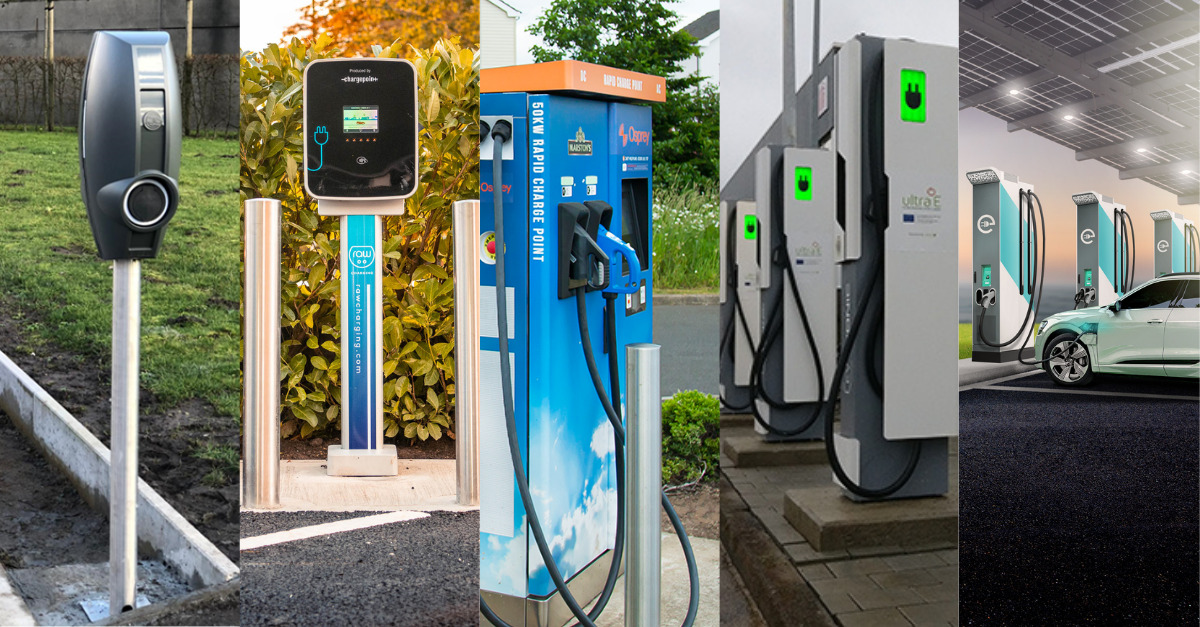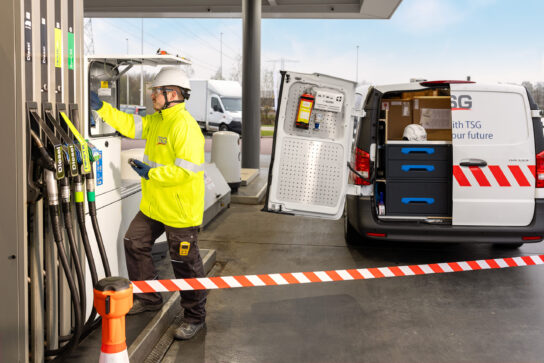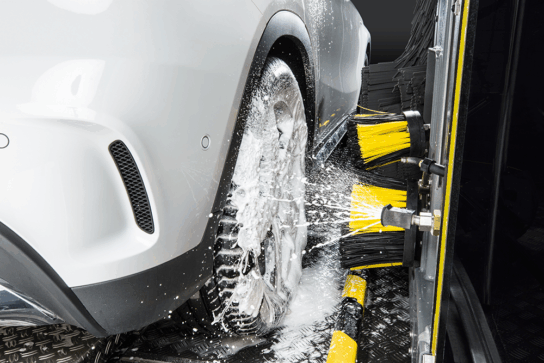The adoption of electric vehicles (EVs) is accelerating across Europe and, as a consequence, the need for a substantial EV charging infrastructure is rising.
There are many different varieties of EV chargers, in terms of speed, connector types and modes. To simplify things, we have broken it down and compared each type, to help customers to understand the uses and benefits of each one.
In this article, we will cover the following points:
- AC & DC chargers
- Charging speeds
- Plug types
- Fleet and heavy transport charging
AC chargers v DC chargers
Electric vehicles can be charged in two ways: AC (alternating current) and DC (direct current).
The power that comes from the grid is AC, however, only direct current can be stored in batteries and therefore a conversion from AC to DC needs to take place during the charging process. The technical difference between AC charging and DC charging is whether the power gets converted outside or inside the vehicle.
AC charging
This is the most common charging method for electric vehicles and whilst considerably slower than DC charging, it is usually much cheaper to top up at AC charge points (due to lower equipment production and installation costs), making them popular for home installation, workplace and general day-to-day charging.
When an EV is charged via an AC charger, the conversion to DC happens inside the vehicle. Charging speeds depend on the output power of the charger and the convertor’s capabilities to transform the power to DC.
DC Charging
DC Chargers are larger and more expensive to build than their counterparts; they convert the current to AC before it enters the vehicle and the power goes directly into the battery, bypassing the car’s converter.
A DC installation requires a lot of power from the grid, resulting in higher tariffs for charging. However, as it usually allows for much faster charging, it is the preferred method to quickly recharge during long-distance trips (for cars that support DC charging) and can provide the driver with an estimate of charge time remaining. This type of charger is usually found along major roads, rather than at home or business locations.
The image below demonstrates the differences between AC and DC charging:
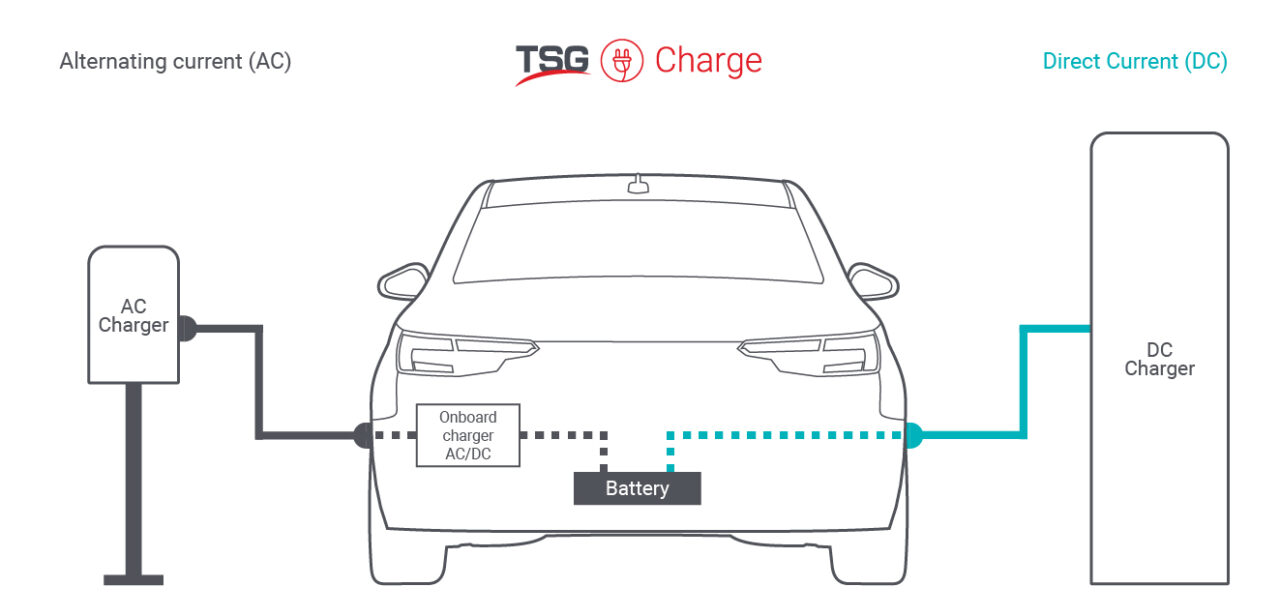
When EVs were first introduced to the market, there were very few DC chargers available, so charging at home (with a slow-paced AC charger) was far more common.
This prompted EV manufacturers to install larger onboard chargers (or converters) in the vehicles. This solution was more than adequate at the time, as EVs were generally fitted with relatively small batteries.
The market has now shifted towards larger battery cars requiring faster charging, resulting in an increase in public DC chargers. Following this trend, most EVs now include both AC and DC charging capabilities. AC on-board chargers are now getting smaller and more cost-effective and as a consequence, the price of EVs has fallen.
The different EV Charging possibilities
As explained, the speed of charging depends on the electric current (AC or DC) but there are other influential factors, such as the power of the charger and the power an EV can handle. In other words, if an EV is topped up at a 100 kW charger, but the vehicle can only handle 50kW, it will charge at 50kW.
The image below provides an overview of the different EV charging possibilities and an indication of the charging speed per type.
Please note these are average charge speeds and actual time taken can be less than shown.
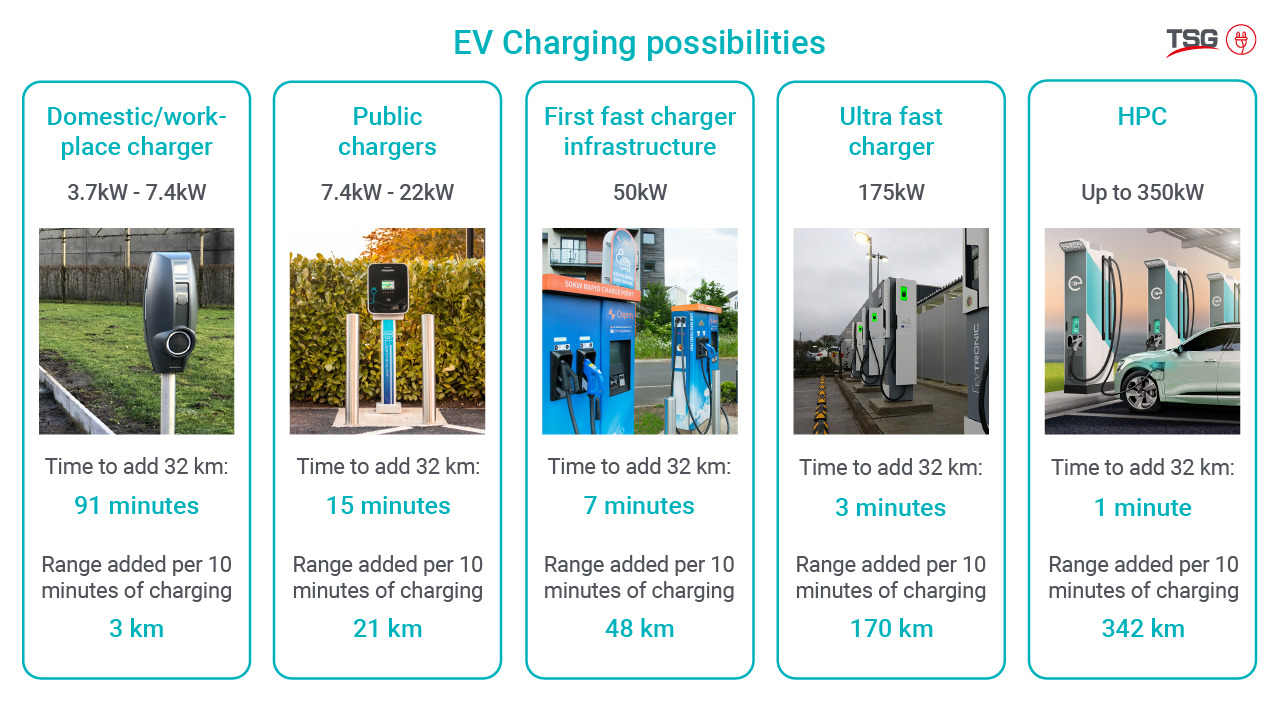
Charger types
Domestic or workplace chargers are usually classed as slow chargers, where EV drivers can charge their car overnight or for 8 hours or more. This could be at home, at the office or even a hotel. These chargers are almost always AC chargers.
Public chargers fully charge a vehicle in a few hours and are therefore typically placed at public parking places, shopping centres and restaurants. Public chargers are usually AC, but it’s not uncommon to mix AC and DC chargers in these locations.
Fast chargers (like public chargers) are typically installed at car parks, supermarkets, leisure centres, car parks and restaurants . They can also be found at service stations, which is ideal for EV drivers with smaller batteries.
Ultra-fast chargers and High-Power-Chargers (HPCs) are by far the quickest way to charge an EV and are therefore perfect for motorway service stations or close to main roads, ensuring EV drivers can complete long journeys with confidence. These chargers are exclusively DC chargers and can charge an electric vehicle rapidly from 0% to 80%, in 20 to 40 min. When situated next to existing service stations, these chargers can form new ‘Fast Charging Hubs’.
Fast chargers and HPCs are complex to install, requiring a full site survey, design, custom electricity supply from the distribution network operator (DNO), equipment supply and installation, maintenance and support. TSG Charge is an expert in this field and able to help and advise operators every step of the way, providing a solution that will suit any commercial business installation.
Read more about TSG Charge
The different types of plugs/connectors across the globe
As electrical vehicles evolved, so did the corresponding plugs (or connectors), which were adapted to meet the electrical network characteristics and the current (AC/DC), resulting in many variations across the globe.
In an effort to establish common European plug standards and ensure interoperability, the Alternative Fuels Infrastructure Directive (AFID) recommended charging points in the EU should be equipped with at least the Type 2 standard (AC) and the Combined Charging System 2 (CCS 2) standard for DC charging. CHAdeMO cars plugs are also still found in Europe but will be gradually phased out, as most EV manufacturers are moving to CCS European Standard.
The image below shows the wide range of plugs/connectors in use around the world.
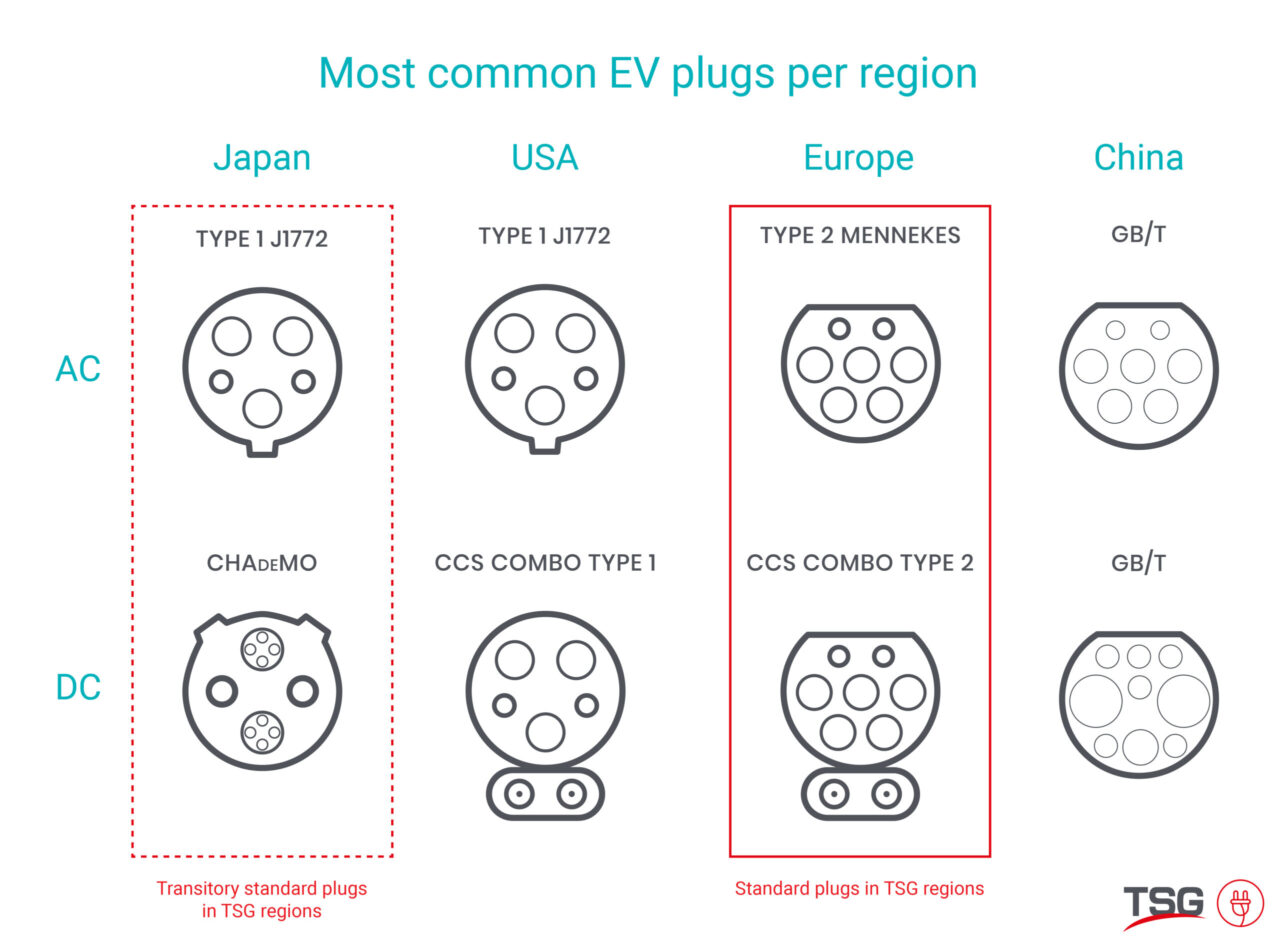
EV chargers for commercial fleet or heavy industry
EV commercial fleets comprise passenger cars (e.g. taxis) or e-Vans (for last-mile delivery), which are usually charged in dedicated parking spaces at the company’s depot.
Typically, these depots install a combination of AC chargers and faster DC chargers, with the majority being AC. Fleet depot installations are very complex in nature, due to the high number of chargers required, the local low-voltage networks and establishing power supply via the distribution network operator (DNO). Often the depot may require the installation of a new electricity connection for a transformer or, in some cases, an electric substation. As an expert in the field, TSG can help to determine the right charge solution for the fleet.
For heavy vehicles, such as e-Buses or e-Trucks, DC Ultrafast chargers are recommended. There are two specific types of chargers that suit heavy vehicles: pantograph chargers and mobile chargers.
Pantograph chargers
A pantograph charger is an extremely powerful overhead charger (up to 450kW) that connects automatically with the e-Bus or e-Truck parked beneath, via rails mounted on the roof of the vehicle. This method of charging is very efficient, as the driver plays no part in this automated process.
Mobile chargers
A mobile direct current fast charger (DCFC) is for electric vehicles for use on the go. It can be compared to a power pack for a mobile phone, only considerably larger. The charger is stored on the vehicle and can be deployed at any time to provide fast roadside charging and ensure that long journeys can be completed with ease. Mobile chargers are relatively new to the market and currently used in the heavy transportation industry, in combination with a dedicated DC charging infrastructure.
Pantograph charger
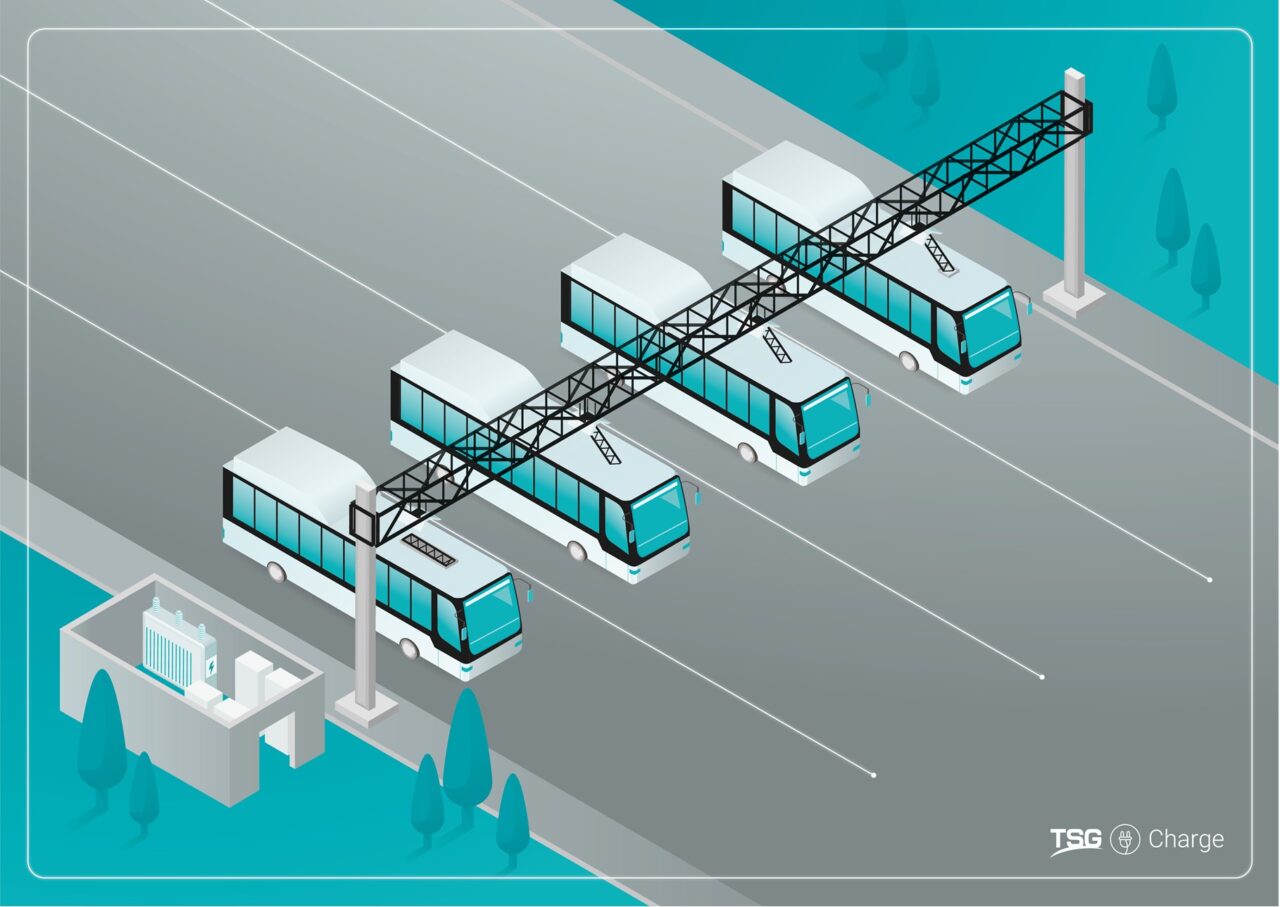
TSG can help operators to find the right solution for their business!
With over 50 years of experience, we are the European leader in the responsible provision of equipment and services in the energy sector, in which E-mobility plays a huge role. Our TSG Charge team provides E-mobility solutions that fit the needs of business operators and their customers.
We take care of the installation project from A to Z. We plan, design, build, deploy and commission the entire EV charging infrastructure. Furthermore, our skilled technicians are always just around the corner to perform maintenance, corrective or preventive.
The TSG Charge experts offer advice on the type of charger that best suits a business, the number of chargers required for the site and the best location, whilst taking into consideration local regulations and restrictions.
TSG Charge – working together with customers, enabling a more sustainable world.
Want to know more? Ask the TSG Charge team!
